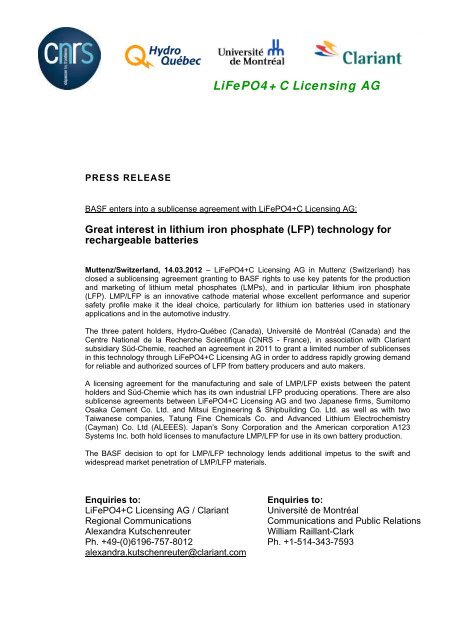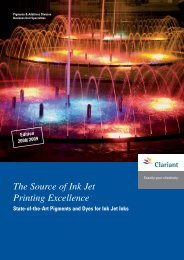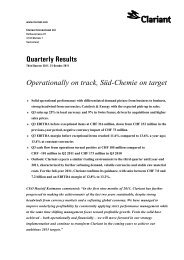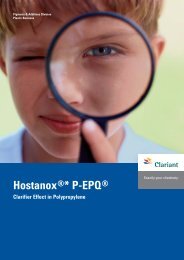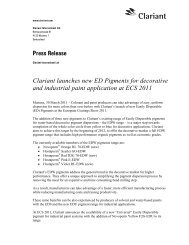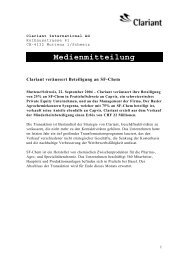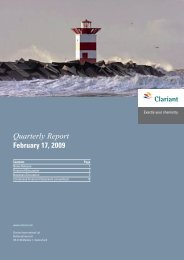Lifepo4+C Licensing AG
Lifepo4+C Licensing AG
Lifepo4+C Licensing AG
Create successful ePaper yourself
Turn your PDF publications into a flip-book with our unique Google optimized e-Paper software.
PRESS RELEASE<br />
LiFePO4+C <strong>Licensing</strong> <strong>AG</strong><br />
BASF enters into a sublicense agreement with LiFePO4+C <strong>Licensing</strong> <strong>AG</strong>:<br />
Great interest in lithium iron phosphate (LFP) technology for<br />
rechargeable batteries<br />
Muttenz/Switzerland, 14.03.2012 – LiFePO4+C <strong>Licensing</strong> <strong>AG</strong> in Muttenz (Switzerland) has<br />
closed a sublicensing agreement granting to BASF rights to use key patents for the production<br />
and marketing of lithium metal phosphates (LMPs), and in particular lithium iron phosphate<br />
(LFP). LMP/LFP is an innovative cathode material whose excellent performance and superior<br />
safety profile make it the ideal choice, particularly for lithium ion batteries used in stationary<br />
applications and in the automotive industry.<br />
The three patent holders, Hydro-Québec (Canada), Université de Montréal (Canada) and the<br />
Centre National de la Recherche Scientifique (CNRS - France), in association with Clariant<br />
subsidiary Süd-Chemie, reached an agreement in 2011 to grant a limited number of sublicenses<br />
in this technology through LiFePO4+C <strong>Licensing</strong> <strong>AG</strong> in order to address rapidly growing demand<br />
for reliable and authorized sources of LFP from battery producers and auto makers.<br />
A licensing agreement for the manufacturing and sale of LMP/LFP exists between the patent<br />
holders and Süd-Chemie which has its own industrial LFP producing operations. There are also<br />
sublicense agreements between LiFePO4+C <strong>Licensing</strong> <strong>AG</strong> and two Japanese firms, Sumitomo<br />
Osaka Cement Co. Ltd. and Mitsui Engineering & Shipbuilding Co. Ltd. as well as with two<br />
Taiwanese companies, Tatung Fine Chemicals Co. and Advanced Lithium Electrochemistry<br />
(Cayman) Co. Ltd (ALEEES). Japan’s Sony Corporation and the American corporation A123<br />
Systems Inc. both hold licenses to manufacture LMP/LFP for use in its own battery production.<br />
The BASF decision to opt for LMP/LFP technology lends additional impetus to the swift and<br />
widespread market penetration of LMP/LFP materials.<br />
Enquiries to:<br />
LiFePO4+C <strong>Licensing</strong> <strong>AG</strong> / Clariant<br />
Regional Communications<br />
Alexandra Kutschenreuter<br />
Ph. +49-(0)6196-757-8012<br />
alexandra.kutschenreuter@clariant.com<br />
Enquiries to:<br />
Université de Montréal<br />
Communications and Public Relations<br />
William Raillant-Clark<br />
Ph. +1-514-343-7593
Enquiries to:<br />
Hydro-Québec<br />
Media and Public Affairs<br />
Stacey Masson<br />
Ph. +1-514 289-2311<br />
Masson.stacey@hydro.qc.ca<br />
About LFP Technology<br />
LiFePO4+C <strong>Licensing</strong> <strong>AG</strong><br />
Enquiries to:<br />
CNRS<br />
Direction de la Communication<br />
Julien Guillaume<br />
Ph. +33 (0)1 44 96 46 35<br />
julien.guillaume@cnrs-dir.fr<br />
Lithium iron phosphate (LiFePO4, LFP) is a novel cathode material that, due to its high<br />
performance and unsurpassed safety profile, has a great deal of potential for use in nextgeneration<br />
lithium ion batteries, used among other things for hybrid and electric drives in the<br />
automotive industry and for stationary energy storage, for instance in solar energy. LFP material<br />
was discovered at the University of Texas in Austin in 1995 and licensed to Hydro-Québec.<br />
When LFP material is coated with a thin layer of carbon, its conductivity is enhanced allowing<br />
LFP’s unique performances. Such layer must be thin enough in order to permit lithium to pass<br />
through. These inventions were protected through the LFP carbon coating patents and the LFP<br />
carbon coating process patents co-owned by Hydro-Québec, Canada, Université de Montréal,<br />
Canada, and Centre National de la Recherche Scientifique (CNRS), France.<br />
About Clariant (www.clariant.com)<br />
Clariant is an internationally active specialty chemical company, based in Muttenz near Basel.<br />
The group owns over 100 companies worldwide and employed 22 149 employees on December<br />
31, 2011. In the financial year 2011, Clariant produced a turnover of CHF 7.4 billion. Clariant is<br />
divided into eleven business units: Additives; Catalysis & Energy; Emulsions, Detergents &<br />
Intermediates; Functional Materials; Industrial & Consumer Specialties; Leather Services;<br />
Masterbatches; Oil & Mining Services; Paper Specialties; Pigments; Textile Chemicals.<br />
Clariant focuses on creating value by investing in future profitable and sustainable growth, which<br />
is based on four strategic pillars: Improving profitability, innovation as well as research and<br />
development, dynamic growth in emerging markets, and optimizing the portfolio through<br />
complementary acquisitions or divestments.<br />
In its battery materials activities, Süd-Chemie (www.sud-chemie.com), a Clariant Group<br />
Company, focuses primarily on developing and manufacturing lithium iron phosphate (LiFePO4,<br />
LFP) – a particularly safe and powerful cathode material. On the new site of its Canadian<br />
subsidiary, Phostech Lithium Inc. in Candiac/Quebec, Süd-Chemie is currently constructing the<br />
world’s first industrial production plant for high quality LFP using a new, proprietary production<br />
process. Commercial production for series delivery will start in 2012 to reach a rate of 2,500 tons<br />
per year. Such volume, will allow the production of approximately 50,000 all-electric automobiles<br />
or, alternatively, up to 500,000 vehicles with hybrid drive per year.
About Hydro-Québec (www.hydro.quebec.com)<br />
LiFePO4+C <strong>Licensing</strong> <strong>AG</strong><br />
Hydro-Québec is a world renowned public utility which generates, transmits and distributes<br />
electricity. Its sole shareholder is the Québec government. It uses mainly renewable generating<br />
options, in particular hydropower, and supports the development of wind energy through<br />
purchases from independent power producers. Hydro-Quebec invests more than $100 million in<br />
R&D in energy-related fields, energy efficiency and energy storage through its research institute<br />
IREQ every year. It has been conducting research in the battery field for over 30 years which<br />
comprises extensive work on advanced materials, particularly molten salts, lithium iron<br />
phosphate and nanotitanates for both high-power and high-energy batteries. Hydro-Quebec's<br />
contribution is helping to develop safe, high-performance lithium-ion batteries that can be<br />
charged more quickly and a greater number of times. The future success of plug-in vehicles<br />
largely depends on the battery.<br />
About Université de Montréal (www.umontreal.ca)<br />
Université de Montréal is the second largest university in Canada and one of the country’s most<br />
cosmopolitan. From its founding in 1878, the university and its affiliated École Polytechnique and<br />
HEC Montréal schools have grown to reach a cumulative enrollment of more than 60,000<br />
students, 7,000 of whom come from abroad. As Québec’s largest university and as a leading<br />
institution in the French-speaking world, Université de Montréal awards more than 11,000<br />
diplomas every year.<br />
The university, its network of affiliated hospitals, and the affiliated schools bring together 2,500<br />
professors and researchers, organized into over 300 research units that represent all the<br />
fundamental disciplines. Recognized for the intensity of its research both in Canada and abroad,<br />
Université de Montréal’s annual budget for basic and applied research exceeds $400 million,<br />
which enables students to work alongside internationally renowned specialists and participate in<br />
exciting breakthroughs.<br />
Research initiatives undertaken by the university’s community involve strong collaboration<br />
between specialists from different disciplines. Université de Montréal supports high level<br />
interdisciplinary research programs in partnership with other institutions and industry, both at the<br />
national and international level.<br />
The work on LFP results from a long term collaboration with Hydro-Québec and CNRS.<br />
About CNRS (www.cnrs.fr)<br />
The Centre National de la Recherche Scientifique (CNRS - National Center for Scientific<br />
Research) is a government-funded research organization, under the administrative authority of<br />
France's Ministry of Research. Founded in 1939 by governmental decree, CNRS has the<br />
following missions: to evaluate and carry out all research capable of advancing knowledge and<br />
bringing social, cultural, and economic benefits for society ; to contribute to the application and<br />
promotion of research results ; to develop scientific information ; to support research training ; to<br />
participate in the analysis of the national and international scientific climate and its potential for<br />
evolution in order to develop a national policy.
LiFePO4+C <strong>Licensing</strong> <strong>AG</strong><br />
As the largest fundamental research organization in Europe, CNRS carried out research in all<br />
fields of knowledge, through its seven institutes, including Institute of Chemistry (INC), and three<br />
national institutes.<br />
CNRS encourages collaboration between specialists from different disciplines in particular with<br />
the university thus opening up new fields of enquiry to meet social and economic needs. CNRS<br />
has developed interdisciplinary programs which bring together various CNRS departments as<br />
well as other research institutions and industry. Interdisciplinary research is undertaken in the<br />
following domains: Life and its social implications, Information, communication and knowledge,<br />
Environment, energy and sustainable development, Nanosciences, nanotechnologies, materials<br />
and Astroparticles: from particles to the Universe.<br />
CNRS benefits from a worldwide renowned team on LFP through the Laboratoire réactivité et<br />
chimie des solides (LRCS - UMR6007).


